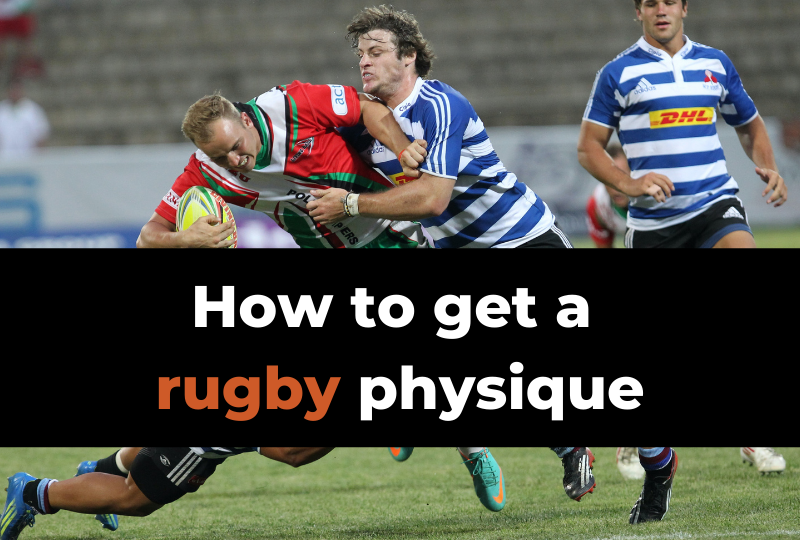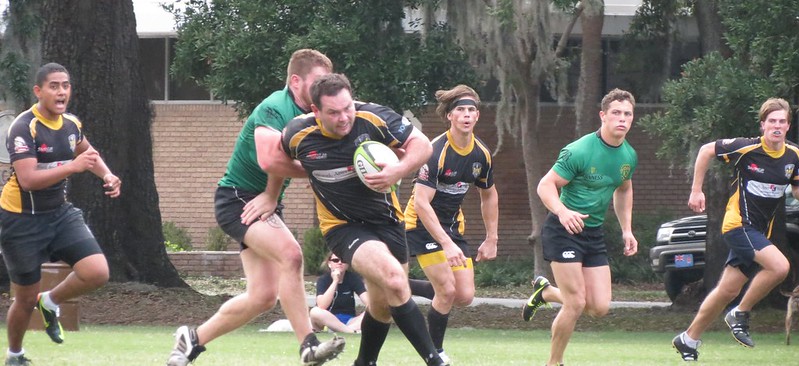Strength. Power. Speed. Athleticism.
These are just four words that personal trainer and former rugby player, Robert Dodds, uses to describe a rugby player’s body.
And they’re enough to reveal why it’s an appealing body type to have.
A rugby player’s body is one that embodies brute strength, skill, and a powerful aesthetic. And thankfully it’s one that anyone can train for, with the right plan and programming.
So how can you get a body like a pro rugby player?

For a beginner who aspires to a physique like a rugby player, they’ll need to build a powerful and muscular body through compound lifts, with an extra emphasis on a broad back, big shoulders, and tree trunk legs. But don’t neglect agility and conditioning — regular HIIT workouts will be a key element of your rugby training.
Let’s take a closer look!
What Are the Hallmarks of the “Rugby Player Physique”?
As well as the words used above, a rugby player’s physique can simply be described as “big.”
Big with pure muscle and relatively low body fat.
“Depending on the position means they come in all different shapes and sizes,” triathlete and coach Scott Liebenberg points out.
“But a typical hallmark across the all rugby players is big shoulders and big legs.”
Rugby is a unique sport in that it requires tons of running or sprinting, along with a high level of physicality (ie tackling) — requiring both a powerful upper and lower body.
Compared to, say, soccer players who run a lot but don’t need as much upper body strength.
As Robert Dodds says, “A typical rugby player physique would include broad shoulders, a large chest, well developed back and huge thighs and glutes.”
Rugby players stand out in a crowd with an imposing physique — but the body is about much, much more than just how it looks.
A rugby physique is a healthy body that’s explosive, immensely strong, and shockingly agile.
The agility comes from the tough moves rugby players make when playing.
You wouldn’t expect such a large form to be able to make precise movements, but it comes with the sport.

Lastly, a highly-conditioned cardiovascular system is something you’ll definitely need with a rugby body.
With a body so large, even just moving around will be tough if you don’t have a fantastic heart and lungs.
So now that you know how a rugby player’s body looks and functions, how can you start training for one as a beginner?
How do rugby players train?
5 Training Tips for a Rugby Player Body
The nutrition and training tips below should get you well on your way to developing a body fit for a rugby player.
There are key parts of the body that you need to train, and you have a long road ahead of you, but these tips will ensure you get a head start on your fitness journey,
1. Get Your Nutrition Right
You’re in for a tough time training, so Scott Liebenberg has nutrition tips you should follow if you want to optimize your diet for your upcoming trials.
He emphasizes how important protein is for accumulating muscle, and it’s true.
Protein is excellent at fueling your body and providing energy. In fact, having a protein bar or shake before or after your training can be highly beneficial.
According to Scott, a rugby player needs 2–2.5 grams of protein per kilogram of body weight per day.
He’s an example he gives:
“A typical 80kg scrum-half would require:
2 x 80kg = 160g protein
If you’re a 115kg prop:
2 x 115 = 230g protein”
Healthy carbs are also essential for maximizing your training.
They’re one of the best nutrients for providing energy, but make sure you get them from a good food source.
You’ll want carbs that will digest and release their energy slowly.
“Have carbohydrate-based foods with your protein to replenish energy stores, such as a banana, dried mixed fruit, milk, or yogurt,” Scott suggests.
“Alternatively, if you cannot stomach a lot of food at first, use weight gaining supplements like protein shakes that are carb-heavy.”
But What About Weight Loss?
As rugby players have relatively low body fat, it might seem counterproductive to eat more and gain weight—but you have to consider how active you’re going to be when training.
You’ll most likely lose some body fat due to your intense training which burns calories.
If you’re a total beginner, you may be able to make muscle gains while losing fat.
And for the rugby physique, that might be plenty. You won’t need to be completely shredded to pull off the look.
As Robert Dodds says, “When you’re in a head-on collision with a man weighing over 100kg, washboard abs aren’t going to protect you”
So, eat those carbs and that protein!
But if you have a lot of extra body fat, a short cutting phase might be in order to get your body into a more athletic and mobile condition.
An effective cut or fat loss phase usually requires eating about 500 calories under your daily maintenance while keeping protein high.
2. Lift Big
“Big lifts are required to get big!” says Scott Liebenberg.
He suggests focusing your training on the main compound lifts like:
These are key exercises to build power and strength, along with a muscular physique.
“Barbells and dumbbells are your friends. All variations of bench press, overhead press and rows should be staples of your training regime,” says Robert Dodds.
If you’re a total beginner, start small and light to learn proper form. Your first day at the gym, you might even just lift the empty barbell.
But you can add weight quickly as a beginner, at the rate of 5+ pounds per workout.
Scott says, “A typical protocol for both strength and muscle building would be a rep range of 5-8 reps at 4-5 sets.”
But you can play with this, of course.
Robert Dodd suggests training near failure and high rep training, too, so vary your workouts for a good combination of power, muscle building, and endurance.
There’s no specific size you need to get to or weight you need to comfortably lift before you’re “done” with your training.
You’ll know when you’re happy with your size by looking in the mirror and comparing yourself to your favorite rugby players.
But building strength in the gym is a never-ending, lifelong process.
3. Train Your Lower Body Hard
“Whilst rugby players are physically imposing and that mainly comes from upper body size and broadness, it’s the lower body that is arguably more important to their dominance on the pitch,” says Robert Dodds.
So along with barbell squats, try adding in some accessory movements for extra muscle gains and power in your legs, like:
- Leg presses
- Deadlifts
- Hack squats
- Lunges
- Bulgarian split squats
If you’re working with sets of 5-8 to build power on the barbell squat, try adding in some of these exercises afterwards to the tune of 8-10 reps or more.
Warning: You’ll be incredibly sore at the beginning of your rugby training, and that’s normal!
4. Build Your Back & Shoulders
Broad shoulders and a built-up back are a staple part of the rugby player’s physique, and the majority of your gains in those areas will come from compound lifts like the overhead press and the deadlift or rows.
However, just like your legs, you’ll want to supplement these areas as much as you can.
Instead of trying for impressive arms with tricep and bicep movements, crush your back with:
- Pull-up variations
- Rowing variations
- Lat pulldowns
And for your shoulders, incorporate:
- Lateral raises
- Rope face pulls
- Rear delt flys
- And more
Again, if you do heavy rows, deadlifts, and overhead presses in the 5-8 rep range, do these accessory exercises in a higher range like 8-12 or 12-15 to further fatigue those muscle groups.
5. Get Agile With Quick HIIT Sessions
Lastly, you don’t want to neglect your conditioning by spending too much time in the weight room.
While the exercises you perform in your regular training offer some cardiovascular benefits, throwing in a few HIIT sessions will be a great addition.
You need agility to have a true rugby body, and you’ll develop it during fast HIIT sessions.
Leaping from one move to the next will ensure your body is highly coordinated and functional. It’s also an extremely efficient way to build better endurance and conditioning.
Most of the work to build a rugby physique will be centered around lifting weights and building muscle.
But without agility, coordination, and good conditioning, you won’t really master the look.
Wrapping Up
Developing a rugby player’s body takes some real work because you need to focus on your whole body.
You need a powerful upper and lower body, and all the while, you have to somehow build awesome cardio endurance and agility.
All the leg work will leave you sore at first, but you’ll find your body becoming more and more powerful extremely quickly with this style of training.
The good news is that you don’t have to have a rippling six pack, so there’s no need to starve yourself. Eat lots of nutritious foods so you can crush your workouts each and every week!
For more, check out:
- How to get a football body
- How to get a wrestler’s body
- How to get a rock climber’s body
- How to get a hockey player body
Hope this helps!